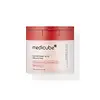What's inside
What's inside
 Key Ingredients
Key Ingredients

 Benefits
Benefits

 Concerns
Concerns

 Ingredients Side-by-side
Ingredients Side-by-side

Water
Skin ConditioningButylene Glycol
HumectantPropanediol
SolventNiacinamide
Smoothing1,2-Hexanediol
Skin ConditioningAlcohol
AntimicrobialPanthenol
Skin ConditioningSuccinic Acid
BufferingGlycerin
HumectantPolyglyceryl-10 Laurate
Skin ConditioningPolyglycerin-3
HumectantTromethamine
BufferingAllantoin
Skin ConditioningSalicylic Acid
MaskingVinyldimethicone
Ethylhexylglycerin
Skin ConditioningCoptis Japonica Root Extract
Skin ConditioningXanthan Gum
EmulsifyingDisodium EDTA
Cyanocobalamin
Skin ConditioningHydrogenated Lecithin
EmulsifyingMentha Piperita Oil
MaskingCitrus Aurantium Bergamia Fruit Oil
MaskingRosmarinus Officinalis Leaf Oil
MaskingProtease
ExfoliatingJuniperus Virginiana Oil
MaskingLavandula Hybrida Oil
EmollientElettaria Cardamomum Seed Extract
PerfumingFoeniculum Vulgare Seed Extract
Skin ConditioningCrocus Sativus Flower Extract
MaskingCoriandrum Sativum Extract
Skin ConditioningTocopherol
AntioxidantWater, Butylene Glycol, Propanediol, Niacinamide, 1,2-Hexanediol, Alcohol, Panthenol, Succinic Acid, Glycerin, Polyglyceryl-10 Laurate, Polyglycerin-3, Tromethamine, Allantoin, Salicylic Acid, Vinyldimethicone, Ethylhexylglycerin, Coptis Japonica Root Extract, Xanthan Gum, Disodium EDTA, Cyanocobalamin, Hydrogenated Lecithin, Mentha Piperita Oil, Citrus Aurantium Bergamia Fruit Oil, Rosmarinus Officinalis Leaf Oil, Protease, Juniperus Virginiana Oil, Lavandula Hybrida Oil, Elettaria Cardamomum Seed Extract, Foeniculum Vulgare Seed Extract, Crocus Sativus Flower Extract, Coriandrum Sativum Extract, Tocopherol
 Reviews
Reviews

Ingredients Explained
These ingredients are found in both products.
Ingredients higher up in an ingredient list are typically present in a larger amount.
Butylene Glycol (or BG) is used within cosmetic products for a few different reasons:
Overall, Butylene Glycol is a safe and well-rounded ingredient that works well with other ingredients.
Though this ingredient works well with most skin types, some people with sensitive skin may experience a reaction such as allergic rashes, closed comedones, or itchiness.
Learn more about Butylene GlycolGlycerin is already naturally found in your skin. It helps moisturize and protect your skin.
A study from 2016 found glycerin to be more effective as a humectant than AHAs and hyaluronic acid.
As a humectant, it helps the skin stay hydrated by pulling moisture to your skin. The low molecular weight of glycerin allows it to pull moisture into the deeper layers of your skin.
Hydrated skin improves your skin barrier; Your skin barrier helps protect against irritants and bacteria.
Glycerin has also been found to have antimicrobial and antiviral properties. Due to these properties, glycerin is often used in wound and burn treatments.
In cosmetics, glycerin is usually derived from plants such as soybean or palm. However, it can also be sourced from animals, such as tallow or animal fat.
This ingredient is organic, colorless, odorless, and non-toxic.
Glycerin is the name for this ingredient in American English. British English uses Glycerol/Glycerine.
Learn more about GlycerinPropanediol is an all-star ingredient. It softens, hydrates, and smooths the skin.
It’s often used to:
Propanediol is not likely to cause sensitivity and considered safe to use. It is derived from corn or petroleum with a clear color and no scent.
Learn more about PropanediolSalicylic Acid (also known as beta hydroxy acid or BHA) is a well-known ingredient for treating skin that struggles with acne and clogged pores. It exfoliates both the skin's surface and deep within the pores to help clear out buildup, control oil, and reduce inflammation.
Unlike AHAs (alpha hydroxy acids), salicylic acid is oil-soluble. This allows it to penetrate into pores which makes it especially effective for treating blackheads and preventing future breakouts.
Salicylic acid is also known for its soothing properties. It has a similar structure to aspirin and can calm inflamed or irritated skin, making it a good option for acne-prone skin that is also sensitive.
Concentrations of 0.5-2% are recognized by the U.S. FDA as an over-the-counter topical acne product.
It can cause irritation and/or dryness if one's skin already has a compromised moisture barrier, so it's best to focus on repairing that before introducing this ingredient into your routine.
While salicylic acid does not increase sun sensitivity, it’s still important to wear sunscreen daily to protect your skin.
If you are looking for the ingredient called BHA or Butylated Hydroxyanisole, click here.
Learn more about Salicylic AcidWater. It's the most common cosmetic ingredient of all. You'll usually see it at the top of ingredient lists, meaning that it makes up the largest part of the product.
So why is it so popular? Water most often acts as a solvent - this means that it helps dissolve other ingredients into the formulation.
You'll also recognize water as that liquid we all need to stay alive. If you see this, drink a glass of water. Stay hydrated!
Learn more about Water